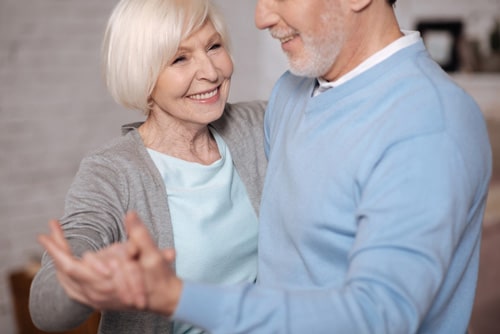Seniors have different goals than young people when it comes to exercise.
Instead of packing on muscle to look buff, they are more likely to want a workout that helps them live independently and continue to do the things they love.
A new study shows that one exercise may be better than all others in reaching this objective.
Dancing promotes cardio fitness while improving balance and coordination. And dancing has a crucial cognitive component that other workouts, such as jogging or bicycling, can’t match.
Dancers constantly learn new steps. They have to coordinate their movements with music. Such mental challenges help seniors’ brains stay sharp. They may even prevent Alzheimer’s, according to the new research.1
The study’s lead author is Dr. Kathrin Rehfeld. She’s with the Center for Neurodegenerative Diseases in Magdeburg, Germany.
Dr. Rehfeld and her colleagues recruited 52 healthy seniors with an average age of 68. They randomly assigned half of the volunteers to take dance classes for 18 months. The other half did other forms of exercise. They included walking, stationary bicycling, strength training, and stretching.2
For the first six months, the dance group met twice a week. After that, they met weekly. Instructors frequently challenged them with new steps.
“We tried to provide our seniors in the dance group with constantly changing dance routines of different genres,” Dr. Rehfeld said. The subjects learned jazz, square, Latin-American, and line dances.
“Steps, arm-patterns, formations, speed, and rhythms were changed every second week to keep them in a constant learning process,” she said.
Dancing Increases Memory and Balance
Brain scans showed that both the dance and exercise groups had increased volume in the hippocampus. This is the brain region that plays an important role in memory, learning, and maintaining balance.
Unlike other regions of the brain, the hippocampus can increase in size throughout life. But the hippocampus also can shrink. This is one of the markers associated with Alzheimer’s disease and other types of dementia.3
Compared to the conventional exercisers, the dancers had beneficial changes to more sub-regions of the hippocampus. The dancers also had improved balance. Conventional exercisers saw no changes in their balancing ability.
The researchers theorize that the “multimodal” nature of dance—it has both physical and mental components—accounted for the extra brain and balance boost.
“Dancing seems a promising intervention for both improving balance and brain structure in the elderly,” the study concluded. “It combines aerobic fitness, sensorimotor skills, and cognitive demands while at the same time the risk of injuries is low.”
The study was published in the journal Frontiers in Human Neuroscience.
Dr. Rehfeld added: “Dancing is a powerful tool to set new challenges for body and mind, especially in older age.”
To get the full mind-body benefits of dancing, be sure to vary your routines. Don’t do the same steps over and over.
By continually learning new dances, you’ll improve in three important areas: cardio, balance, and memory.
Editor’s Note: The symptoms of aging are just like any others. They can be treated or eliminated. Go here to discover specific ways you can stop the clock.
Like this Article? Forward this article here or Share on Facebook.
References:
1 https://blog.frontiersin.org/2017/08/29/dancing-can-reverse-the-signs-of-aging-in-the-brain/
2 https://consumer.healthday.com/cognitive-health-information-26/brain-health-news-80/dance-your-way-to-a-healthier-aging-brain-726264.html
3 https://www.frontiersin.org/articles/10.3389/fnhum.2017.00305/full

